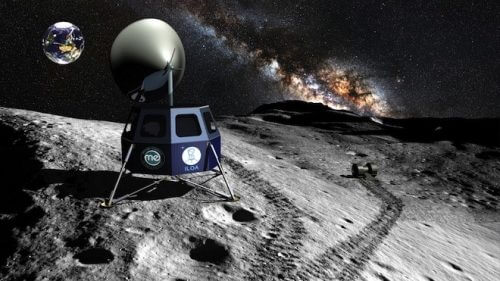According to the organization that finances the project and the company that builds the spacecraft and the telescope - it will photograph the Milky Way galaxy and make astrophysical observations,

Private space companies promise at least to fulfill one of the digital fantasies - to establish an observatory on the moon. It will not be placed on the far side nor will it be manned but this is also a step in the right direction.
The International Lunar Observatory Organization (ILOA) and space systems manufacturer Moon Express have announced a collaboration to deliver the first international observatory to the lunar south pole in 2019 (ILO-1). Back in 2013, Moon Express was awarded a contract by ILOA to develop advanced landing technologies that support the mission.
The ILO-1 Astrophysical Observatory and Research Station will be the first telescope in the world to image the Milky Way galaxy and conduct international astrophysical observations as well as communications from the lunar surface.
ILO-1 will land near the "Peak of Eternal Light" at the South Pole using a Moon Express robotic explorer system. The exact landing site will be determined after a careful analysis of Mount Malapart, a 5 kilometer high peak in the Aitkin Basin, illuminated by sunlight most of the day and has a 24/7 line of sight to Earth and is also close to Shackleton Crater which is shaded all year round. The idea is to place the telescope in a shaded area but connect it to a solar collector system that will be in a lit area. Moon Express will also use the mission to explore the South Pole region of the Moon and look for water and minerals.
"The primary goal of the International Lunar Observatory is to expand human knowledge of the galaxy and the universe through observation and communication from our Moon," said ILOA Founder and CEO Steve Dorsett. "We are very excited to work with Moon Express and restore humanity's presence on the moon in 2019, the anniversary year of Apollo 11. Even if it is a robotic system."
Moon Express says it is developing precision landing and hazard avoidance technologies that will enable the lunar robotic lander to place ILO-1 in the challenging terrain of the moon's south pole.
The editor's note of the knowledge website: proving the claims - is the responsibility of the bodies that claim it.

4 תגובות
According to their website the diameter of the telescope's main mirror is about the last thing they care about. It is easier to find the size of the antenna that will send the information to Earth (accompanied by incredibly ridiculous illustrations in which the antenna is not directed towards the Earth at all - and the telescopic part is completely missing).
Only one of their early illustrations indicates that the telescope is
” zz 14″ Scmhi dt Cassegrain telescope equivalent to LX200″.
And given that it's designed to watch the Milky Way and in no way the very dim things that are in really deep space, that's probably acceptable. Maybe.
Besides, it seems that their site stopped being updated at the end of 2005. Also, the shape of the site seems to have been preserved in a time capsule from the past. I wonder if there is anything more to this news than a press release.
Does anyone know what size the first mirror is?
I guess because of all the complication of having to fly to the moon and landing etc.. it will be necessary to reduce the size
to plant:
A space telescope constantly has problems with the sun. When aiming the telescope at a new target, there are areas that go from light to shadow, and vice versa. Areas warm and expand, and other areas cool and contract. As a result there are vibrations that do not allow the telescope to operate until the matter calms down. A telescope that is always in the shade is an advantage.
In addition to this, a space telescope needs a long tube that always hides the mirror so that sunlight does not damage it. Sunlight will heat part of the mirror and distort it. And sunlight will scatter and reach the detector.
In addition, it is possible to save the gyroscopes that stabilize the direction of the telescope, which have already been replaced in vain, and in the Kepler telescope they were broken beyond repair.
There are disadvantages: the distance from the country is further and will make repairs difficult, you have to land on the surface, and the split structure with a connecting cable between the two parts also complicates the installation a lot.
What advantage, if any, does it have over a space telescope?